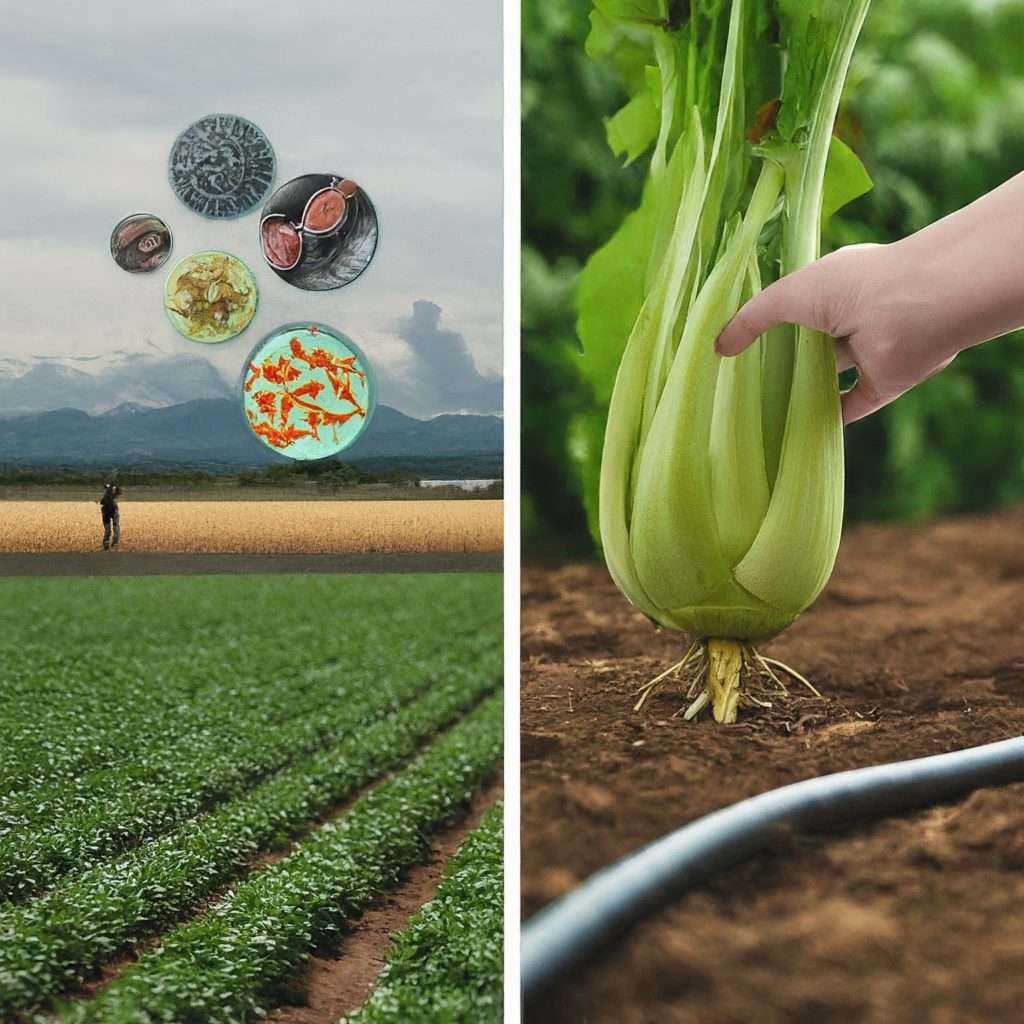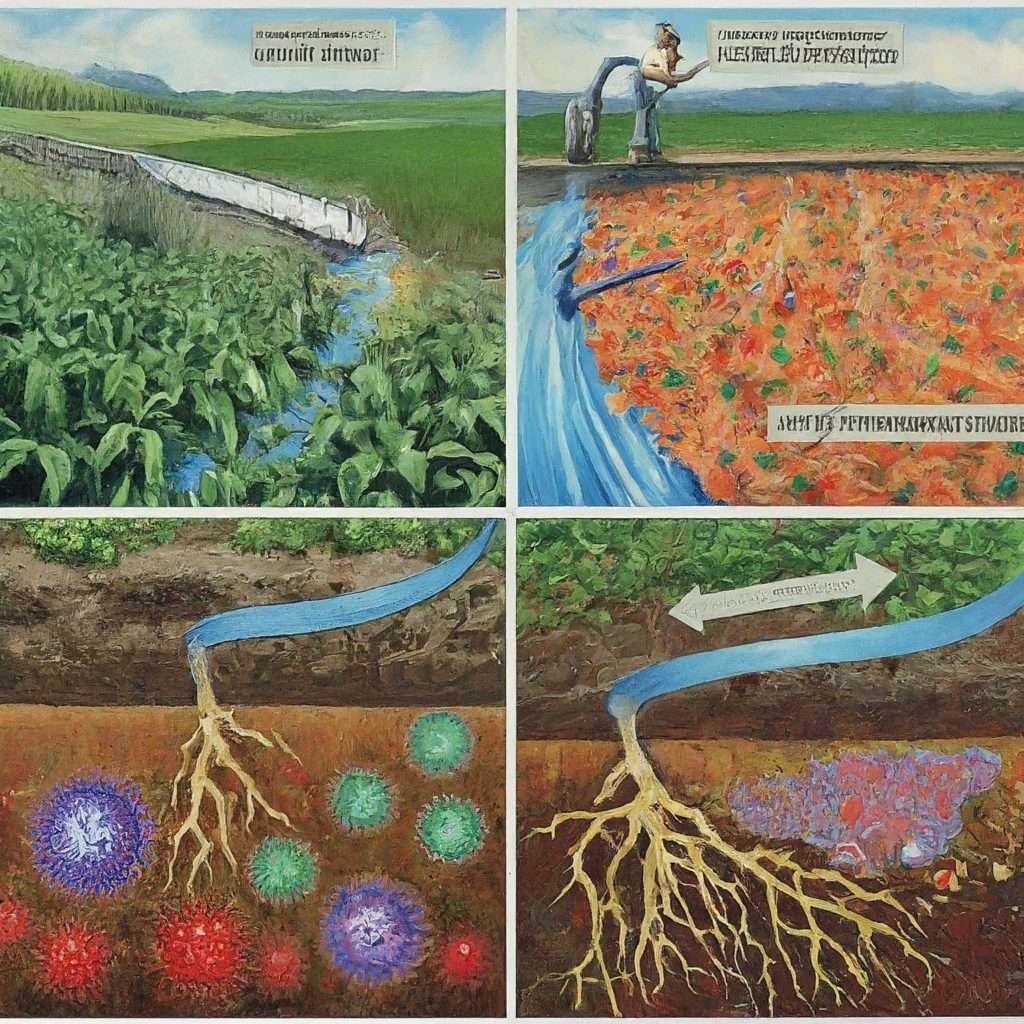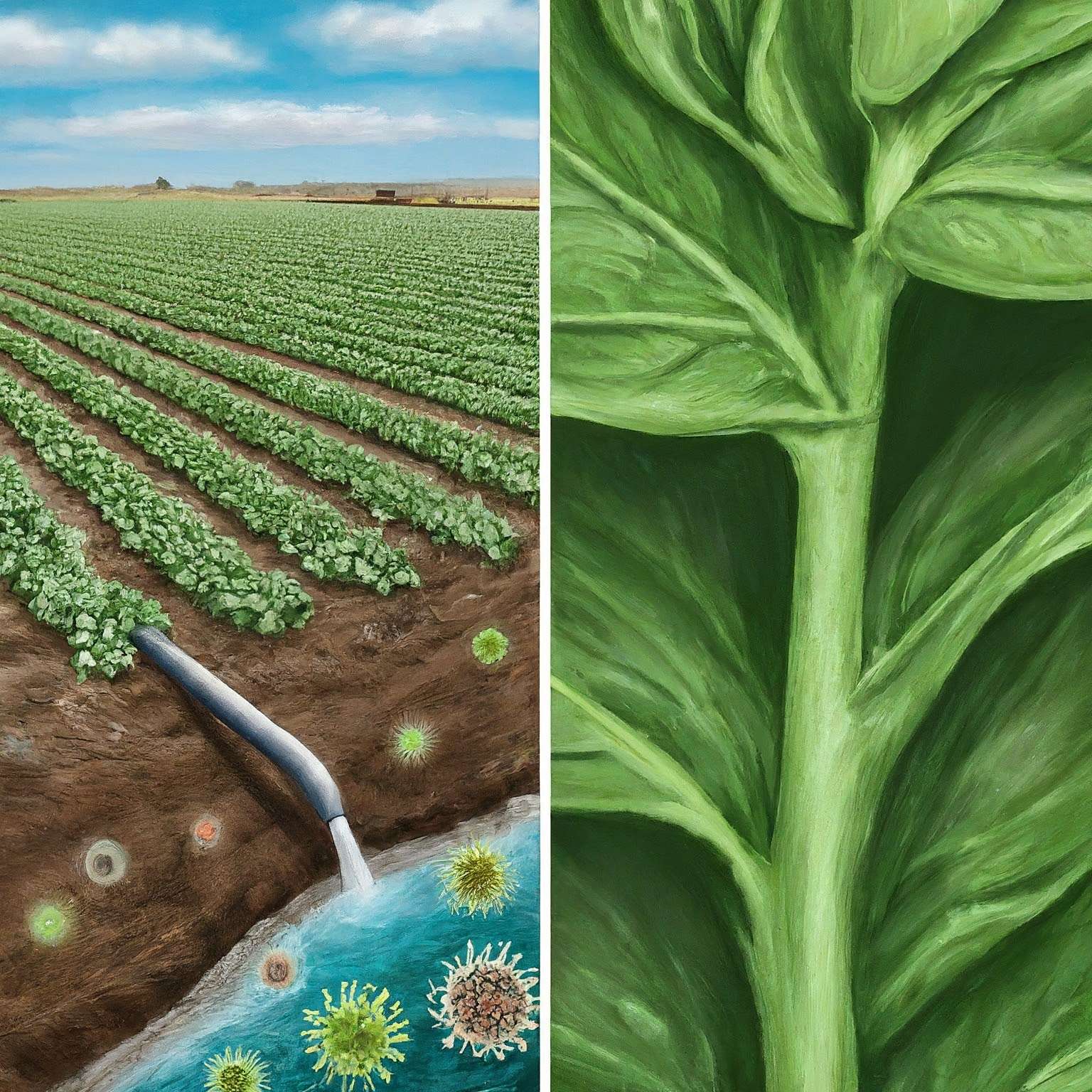We all know the importance of a healthy diet. Fresh fruits and vegetables are packed with vitamins, minerals, and the fuel our bodies need to thrive. But what if the very process that helps these foods flourish also harbors a hidden risk? Shockingly, some common irrigation methods used in agriculture can actually pose a threat to our health.
Imagine enjoying a crisp salad, completely unaware that the water used to grow those leafy greens might be contaminated with harmful bacteria. This isn’t fearmongering; it’s a real concern facing modern agriculture. In this article, we’ll delve into the surprising truth about irrigation and its potential impact on human health. We’ll explore how certain watering practices can introduce dangerous pathogens into the food chain, leading to a variety of illnesses.

But fear not, knowledge is power! We’ll also unveil safer irrigation alternatives that not only nourish our plants but also safeguard our wellbeing. Buckle up, as we expose the shocking truth behind your watering habits and reveal how to keep your food – and yourself – healthy.
II. The Problem: Unhealthy Irrigation
The magic of transforming a seed into a bountiful harvest relies heavily on irrigation, the artificial application of water to land. While this practice is crucial for agriculture, not all irrigation methods are created equal. Some traditional approaches, while seemingly straightforward, can inadvertently introduce health risks into our food system. Let’s explore the most common irrigation techniques and understand how some methods pose a greater threat than others.
A Spectrum of Watering Techniques:
- Flood Irrigation: This age-old method blankets fields with water, allowing it to soak into the soil. While simple and inexpensive, flood irrigation suffers from inefficiency. It can lead to water waste through evaporation and runoff, especially on uneven terrain. Additionally, excess water can stagnate, creating a breeding ground for harmful pathogens.
- Sprinkler Irrigation: This approach simulates rainfall by spraying water through overhead fixtures. While it offers better water distribution compared to flood irrigation, sprinkler systems still have limitations. Wind can cause uneven water application, and droplets can linger on plant surfaces, potentially promoting fungal diseases.
- Drip Irrigation: This modern technique delivers water directly to the root zone of plants through a network of tubes or emitters. Drip irrigation boasts exceptional efficiency, minimizing water waste and evaporation. Since water doesn’t reach the entire field surface, it also reduces the risk of disease spread and soil erosion.
The Culprit: Flood Irrigation and Waterborne Pathogens
Now, let’s delve deeper into why some irrigation methods pose health risks. Our primary concern lies with flood irrigation and its potential to contaminate water and soil with harmful pathogens. These microscopic organisms, like bacteria, viruses, and parasites, can thrive in stagnant water. When flood irrigation allows water to pool on the surface, it creates a perfect breeding ground for these pathogens.
Contamination can occur in several ways. Contaminated water sources used for irrigation, such as untreated wastewater, can introduce pathogens directly. Additionally, flood irrigation can mobilize existing pathogens in the soil, allowing them to rise to the surface and potentially come into contact with the edible parts of crops.
From Field to Fork: The Contamination Chain
Once pathogens find their way into the irrigation water, they initiate a worrying chain reaction. As floodwater soaks into the soil, it carries pathogens along with it. These pathogens can then adhere to the roots of plants or contaminate the lower parts of fruits and vegetables that come into direct contact with the soil.
Furthermore, contaminated irrigation water can splash onto the edible portions of crops during the irrigation process, further increasing the risk of contamination. This becomes a significant concern for leafy greens and low-growing vegetables as they have a larger surface area exposed to potential pathogens.
The Price We Pay: Health Risks from Contaminated Water
The consequences of consuming food contaminated with waterborne pathogens can be severe. Common health problems associated with contaminated irrigation water include gastrointestinal illnesses like diarrhea, vomiting, and cramps. In some cases, exposure to more virulent pathogens can lead to more serious illnesses.
Children, pregnant women, and individuals with weakened immune systems are particularly vulnerable to the effects of contaminated water. For these populations, even a mild case of foodborne illness can have serious health complications.
By understanding the risks associated with unhealthy irrigation practices, we can advocate for safer methods that nurture our food sources while safeguarding public health.
III. Exposing the Risks: Unveiling the Science of Contamination
While flood irrigation offers a seemingly simple solution for watering crops, the science behind its potential health risks paints a concerning picture. Here, we’ll expose the specific dangers associated with this method and illustrate the path pathogens take from contaminated water to our plates.
Dangerous Dwellers:
Flood irrigation’s biggest threat lies in its ability to harbor and spread harmful pathogens. These microscopic invaders, like E. coli and Salmonella, can thrive in stagnant water. Their presence in irrigation water sets off a domino effect, jeopardizing both soil and plant health.
Contamination Pathway (See Diagram Below):

- Source of Trouble: The initial contamination can originate from various sources. Untreated wastewater used for irrigation can be laden with pathogens. Additionally, naturally occurring pathogens present in the soil can be mobilized by floodwater.
- Stagnant Breeding Ground: As floodwater saturates the field, it creates stagnant pools. This lack of movement provides an ideal environment for pathogens to multiply.
- Soil Infiltration: Over time, contaminated water percolates into the soil, carrying pathogens along with it. These pathogens can then adhere to plant roots or contaminate the lower parts of fruits and vegetables that come into direct contact with the soil.
- Splash Zone: During irrigation, contaminated water can splash onto the edible portions of crops, particularly leafy greens and low-growing vegetables. This direct contact significantly increases the risk of contamination on the parts we consume.
Visualization of the Contamination Process:
Imagine a diagram with four panels:
- Panel 1: Depicts a field with a water source (river or reservoir) and a farmer activating a flood irrigation system.
- Panel 2: Shows close-up details of stagnant water on the field surface, highlighting magnified images of pathogens multiplying.
- Panel 3: Illustrates the water infiltrating the soil, carrying pathogens with it (use arrows to depict movement). Show magnified images of pathogens near plant roots and on the lower parts of vegetables.
- Panel 4: Illustrates contaminated water splashing onto the leaves of leafy greens.
By understanding this contamination pathway, we can appreciate how flood irrigation practices directly translate to potential health risks on our dinner plates.
IV. Seeking Solutions: A Drip on the Problem
The good news is that the risks associated with flood irrigation aren’t a dead end. We have a solution: a more efficient and health-conscious approach called drip irrigation.
Drip Irrigation: A Precise Delivery System
Drip irrigation represents a paradigm shift in watering practices. Unlike flood irrigation’s blanket approach, drip irrigation delivers water directly to the root zone of plants through a network of tubes or emitters. This targeted delivery system offers a multitude of benefits for both farmers and consumers.
Healthier Food, Healthier People:
By minimizing water pooling on the soil surface, drip irrigation significantly reduces the risk of pathogen contamination. Water reaches the plant roots directly, limiting the potential for pathogens to spread from water to soil and ultimately onto the edible parts of crops. This translates to a significant decrease in the risk of foodborne illnesses associated with contaminated irrigation water.
Economic Boon for Farmers:
While the initial investment in drip irrigation systems might be slightly higher than flood irrigation, the long-term economic benefits are undeniable. Drip irrigation’s water efficiency translates to significant cost savings. Farmers can use less water to achieve the same – or even better – crop yields. Additionally, drip irrigation reduces the risk of waterlogging, a problem that can damage plants and decrease productivity.
Environmental Champion:
Drip irrigation is a champion for the environment. Its water efficiency translates to less water being extracted from rivers and aquifers. This helps conserve precious water resources, particularly in drought-prone regions. Additionally, drip irrigation minimizes runoff, which can carry pollutants into waterways and disrupt ecosystems.
Resources for a Sustainable Future:
The transition towards safer irrigation practices requires collaboration and education. Here are some resources that farmers can utilize to learn more about drip irrigation and implement it in their fields:
- The Food and Agriculture Organization of the United Nations (FAO): The FAO offers a wealth of information on irrigation practices, including detailed guides on drip irrigation systems and their benefits.
- Local Agricultural Extension Services: These services provide farmers with access to technical expertise and resources tailored to their specific needs. They can offer guidance on selecting and implementing drip irrigation systems suitable for their crops and land.
- Drip Irrigation Manufacturers: Reputable manufacturers of drip irrigation systems can provide detailed information on their products, including installation guides and ongoing support.
By embracing drip irrigation, farmers can ensure the health and safety of consumers while safeguarding valuable resources for future generations. This shift paves the way for a more sustainable and responsible agricultural future, where healthy food goes hand-in-hand with a healthy planet.
V. Conclusion: Watering Wisely for a Healthier Future
The link between irrigation practices and public health may come as a surprise, but it’s a crucial factor to consider in ensuring a safe and sustainable food system. Flood irrigation, while seemingly simple, can inadvertently create a breeding ground for harmful pathogens, posing a risk of contamination to the very crops that nourish us. Thankfully, we’re not powerless in the face of this threat.
Drip irrigation offers a compelling solution. This targeted watering method delivers water directly to plant roots, minimizing water waste and reducing the risk of pathogen contamination. The benefits extend far beyond public health. Drip irrigation empowers farmers with greater efficiency, leading to cost savings and improved crop yields. Additionally, it conserves precious water resources and minimizes environmental pollution, promoting a more sustainable agricultural future.
Addressing the issue of unhealthy irrigation practices requires a collective effort. Farmers play a central role by embracing sustainable irrigation techniques like drip irrigation. By adopting these practices, they safeguard the health of consumers while securing the future of their own agricultural endeavors.
As consumers, we also have a role to play. By supporting initiatives that promote safe irrigation practices, we can advocate for a responsible and sustainable food system. Look for labels that indicate produce grown using sustainable irrigation methods. Engage with local farmers’ markets and inquire about their irrigation practices. By making informed choices, we can empower those who are making the shift towards a healthier and more sustainable future.
The journey towards a healthier food system begins with a single drop of water. By ensuring that each drop reaches its intended target – nourishing the plant, not harboring pathogens – we can create a ripple effect of positive change. Let’s work together to ensure that our watering habits promote not only thriving crops but also a healthy and sustainable future for all.
